Teaching on Mars: Some Lessons Learned from an Earth-Bound Study into Community Open Online Courses (COOCs) as a Future Education Model Rooted in Social Justice
Abstract
1. Introduction
‘change education out of recognition: partly by the new opportunities they present and partly by their threat to existing institutions, systems and structures’.(p. 569)
1.1. The Community Open Online Courses (COOCs) Project
1.2. Aims and Objectives
1.3. Concepts of Roles in Education across MOOC Types and COOCs
‘xMOOCs are instructivist and individualist, use classic e-learning platforms and are based on resources, cMOOCs are connectivist and are based on social learning, cooperation and use of web 2.0’.(p. 2)
1.4. Theoretical Framework: Popular Education as a Prioritising of Community over Massiveness
- ‘Rooted in the real interests and struggles of ordinary people
- Overtly political and critical of the status quo
- Committed to progressive social and political change’ [11], (p. 2).
1.5. Popular Education as a Rethinking of Common Sense
‘The consequence of the substitution of technology for pedagogy is that instrumental goals replace ethical and political considerations, diminishing classroom control by teachers while offering a dehumanizing pedagogy for students’.(p. 124)
Google is effectively the common sense understanding of what using the internet actually means … one writes with a pen, makes calls with a phone, and searches the internet.[28], (p. 14)
‘a criticism of ‘common sense’ basing itself, however, on common sense in order to demonstrate that ‘everyone’ is a philosopher and that is not a question of introducing from scratch a scientific form of thought …but renovating and making ‘critical’ an already existing activity’.[18], (p. 638)
‘…advocacy of the need for subaltern groups to gain the means to critically appropriate established ‘high status’ cultural forms and knowledge with a view to moving from the margins to the center’.[30], (p. 23)
1.6. Challenges to Community as a Meaningful Space for Learning
‘communities embed knowledge and standardize practice …MOOCs disrupt existing patterns of thinking and introduce people to new connections and new ideas’.[34], (p. 30)
2. Materials and Methods: Establishing an Earthly Context
‘The new categories of scholarly activity must take the form of action research. What else could they be?’[37], (p. 31)
‘not the task of the action researcher to describe the world as it is, but to realize visions of what the world can become’.[39], (p. 167)
2.1. Cyclical Research Process
2.2. Sampling
- -
- Organisational representative (OR)
- -
- Working in adult education (WAE)
- -
- Student in adult education (SAE)
- -
- Community educator (CE)
- -
- Community but not educator (C)
- -
- Individual (no affiliation) (I)
2.3. Methods of Data Collection
2.4. Data Analysis Considerations
3. Results and Discussion
3.1. Gatekeeping and Vulnerability
3.2. Pyramids of Power
‘Technological advances are functionally integrating us to the ideological circuits and global imperatives of the transnational capitalist class, prompting us to perform our identities according to the hidden transcript of the neoliberal agenda: to create consumer citizens through a comprador class cyber-citizenry who serve as sentinels that ensure the promulgation of a colonial mentality’.[47], (p. 264)
“digital education is somewhere we find ourselves, nobody teaches it, they just lay it out there, expectantly, they don’t provide a guide to the pyramid we are part of, the privacy and ownership issues, our place in the big picture …nobody teaches that”.(Participant, Tony)
“…are there because society creates a greed is good approach, they respond to that, a money first ethos that squashes social good”.
“The pyramid I get, but not what we are in it, are we bottom or top? Who is the rest? I know that people own my data, is that true of the project too? But who are the rest and are they national or what? We are so tiny it can be off-putting, frightening…who is seeing us or using us for something we don’t know”.(Kim, focus group)
3.3. Challenging Common Sense: Toward a Gonzo Education that Modernises Static Visions of Educational Practice
- Operates from an understanding of the blurred boundaries and the messy hinterlands of institutional, semi-institutional and noninstitutional education. An approach that recognises and describes the interplay between these spaces.
- That allows for multiple authors, designers and creators of learning without any a priori concern over rights to develop these.
- Describes a discursive space that does not require adherence to any theoretical or philosophical model—in this it reflects the actual lived reality of any educational experience.
- Additionally, does not deny the influence/application of theoretical models but that they include the actual practices/experiences of those involved.
- Involves the educator and students in the discussion of any exercise or reflective practice of an educational event. This removes the danger of actions being interpreted by analytical processes that exclude the intent of those involved.
- Begins with means and ends as essential reflective points. These may not be clear or agreed but help clarify the foundations on which any learning process is built.
- Contends that participation is better than perfection, that being engaged in shaping knowledge holds more value than accessing already wholly developed concepts produced by others.
4. Conclusions
Funding
Acknowledgments
Conflicts of Interest
Appendix A
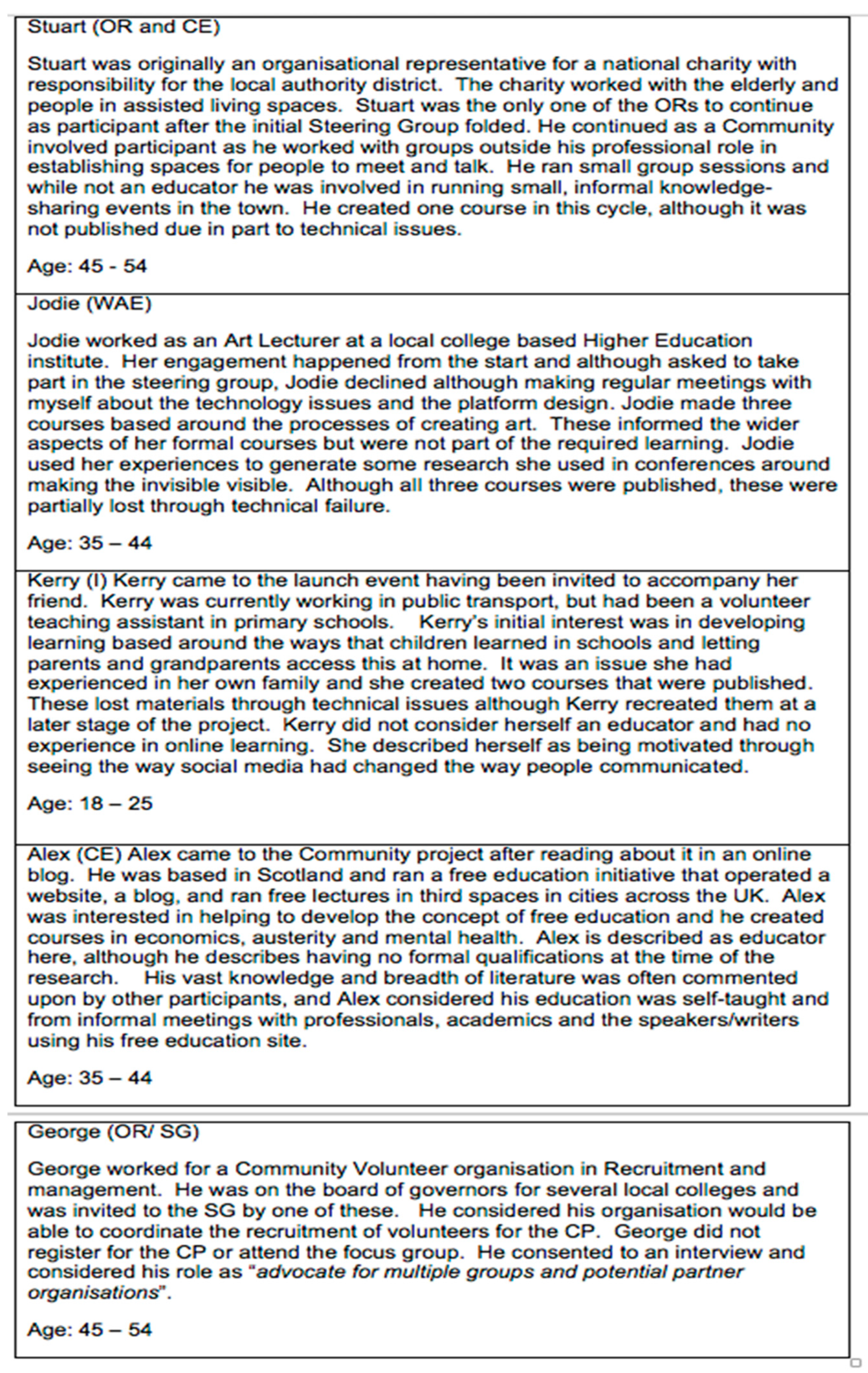
Appendix B
| Data Collection Method | Occurrences in Cycle One | Occurrences in Cycle Two | Occurrences in Cycle Three |
|---|---|---|---|
| Journal/Blogs | 1 × main author | 1 × main author 2 × participant blogs | 1 × main author 1 × participant blogs |
| Social Media | No use | 23 × group discussions 8 × individual posts | 13 × group discussions 17 × individual posts |
| Interviews (one-to-one) | 3 × interviews (spoken) | 11 × interviews (spoken) 4 × online interviews (video) 2 × online interviews (typed) | 12 × interviews (spoken) 3 × online interviews (video) 5 × online interviews (typed) |
| Focus groups | 2 × focus groups | Not used | Not used |
| Nominal Group Technique (NGT) | Not used | 2 × NGT | 2 × NGT |
| Delphi Technique (DT) | Not used | 1 × DT | 1 × DT |
| Documentary |
|
|
|
References
- Toyama, K. Technology as Amplifier in International Development. In Proceedings of the 2011 I-Conference, Seattle, WA, USA, 8–11 February 2011; pp. 75–82. [Google Scholar]
- Holford, J.; Jarvis, P.; Milana, M.; Waller, R.; Webb, S. The MOOC Phenomenon: Toward lifelong education for all? Int. J. Lifelong Educ. 2014, 33, 69–572. [Google Scholar] [CrossRef]
- Selwyn, N. Massive Open Online Change? Exploring the Discursive Construction of the MOOC in Newspapers. High. Educ. Q. 2015, 69, 175–192. [Google Scholar] [CrossRef]
- Haggard, S. The Maturing of the MOOC: Literature Review of Massive Open Online Courses and Other Forms of Distance Learning; UK Government, Department for Business, Innovation & Skills. The Stationery Office: London, UK, 2013.
- Veletsianos, G.; Sheperdson, P. A Systematic Analysis and Synthesis of the Empirical MOOC Literature Published in 2013–2015. Int. Rev. Res. Open Distrib. Learn. 2016, 17, 198–221. [Google Scholar] [CrossRef]
- Shukie, P. A Participatory Action Research Investigation Into An Open, Online Community Project Exploring How Teaching And Learning Occur In A Non-Institutional, Non-Specialist, Technology Enhanced Learning Environment. PhD Thesis, Lancaster University, Lancaster, UK, 2018. Available online: https://doi.org/10.17635/lancaster/thesis/287 (accessed on 16 September 2019).
- Siemens, G. Connectivism: A learning theory for a digital age. Int. J. Instr. Technol. Distance Learn. 2005, 2, 3–10. [Google Scholar]
- Fidalgo-Blanco, A.; Sein-Echaluce, M.; Garcia-Penalvo, L. From Massive Access to Cooperation: Lessons learned and proven results of a hybrid xMOOC/cMOOC pedagogical approach to MOOCS. Int. J. Educ. Technol. High. Educ. 2016, 13, 1–13. [Google Scholar] [CrossRef]
- Freire, P. Pedagogy of the Oppressed: 30th Anniversary Edition; Continuum: London, UK, 2005. [Google Scholar]
- Freire, P. Education and Community Involvement. In Critical Education in the New Information Age; McLaren, P., McLaren, P., Eds.; Rowan & Littlefield Publishers: Lanham, MD, USA, 1999. [Google Scholar]
- Crowther, J.; Galloway, V.; Martin, I. Popular Education: Engaging the Academy; NIACE: Leicester, UK, 2015. [Google Scholar]
- Bayne, S.; Ross, J. Manifesto for Teaching Online 2016. Available online: https://onlineteachingmanifesto.wordpress.com/the-text/ (accessed on 8 February 2018).
- Biesta, G. Don’t be fooled by Ignorant Schoolmasters: On the role of the teacher in emancipatory education. Policy Futures Educ. 2017, 15, 52–73. [Google Scholar] [CrossRef]
- Wiggins, N. Critical Pedagogy and Popular Education: Toward a unity of practice. Stud. Educ. Adults 2011, 43, 34–49. [Google Scholar] [CrossRef]
- St. Clair, R. On the Commonplace: Reclaiming Community in Education. Adult Educ. Q. 1998, 49, 5. [Google Scholar] [CrossRef]
- Martin, I.S. New Times: New Directions? Adults Learn. 1993, 4, 143–145. [Google Scholar]
- Landy, M. Socialist Education Today: Pessimism or optimism of the intellect? In Rethinking Gramsci; Green, M., Ed.; Routledge: London, UK, 2011. [Google Scholar]
- Gramsci, A. Selections from the Prison Notebooks; Lawrence & Wishart: London, UK, 1972. [Google Scholar]
- Watkins, E. Gramscian Politics and Capitalist Common-Sense. In Rethinking Gramsci; Green, M., Ed.; Routledge: London, UK, 2011. [Google Scholar]
- Laurillard, D. Teaching as a Design Science: Building Pedagogical Patterns FOR Learning and Technology; Routledge: London, UK, 2012. [Google Scholar]
- Laurillard, D. Technology Enhanced Learning as a Tool for Pedagogical Innovation. J. Philos. Educ. 2008, 42, 521–533. [Google Scholar] [CrossRef]
- Robinson, A. Toward an Intellectual Reformation: The critique of common sense and the forgotten revolutinary project of Gramscian theory. Crit. Rev. Int. Soc. Political Philos. 2005, 8, 469–481. [Google Scholar] [CrossRef]
- Kanuka, H. Understanding e-Learning Technologies-in-Practice through Philosophies-in-Practice. In Theory and Practice of Online Learning; Anderson, T., Elloumi, F., Eds.; Athabasca University Press: Athabasca, AB, Canada, 2008; pp. 91–118. [Google Scholar]
- Parchoma, G. Toward Diversity in Researching Teaching and Technology Philosophies-in-Practice in e-Learning Communities. In Handbook of Research on Methods and Techniques for Studying Virtual Communities: Paradigms and Phenomena; Daniel, B., Ed.; IGI Global: Hershey, PA, USA, 2011; Volume 1. [Google Scholar]
- Giroux, H. The University in Chains: Confronting the Military-Industrial Academic Complex; Paradigm Publishers: Boulder, CO, USA, 2007. [Google Scholar]
- Mirrlees, T.; Alvi, S. Managing with MOOCS: Taylorising academia, deskilling professors and automating Higher Education. J. Crit. Educ. Policy Stud. 2014, 12, 45–73. [Google Scholar]
- Hall, S.; O’Shea, A. Common Sense Neoliberalism. Soundings 2013, 55, 9–25. [Google Scholar] [CrossRef]
- Buchanan, I. Deleuze and the Internet. Aust. Humanit. Rev. 2007, 43, 1–19. [Google Scholar]
- Berners-Lee, T. Weaving the Web: The Original Design and Ultimate Destiny of the World Wide Web; Harper Collins: New York, NY, USA, 2000. [Google Scholar]
- Mayo, P. Gramsci, Freire and Adult Education: Possibilities for Transformative Action; Zed Books: London, UK, 1999. [Google Scholar]
- Allman, P. Gramsci, Freire & Illich: Their contributions to education for socialism. In Radical Approaches to Education; Lovett, T., Ed.; Routledge: London, UK, 1988. [Google Scholar]
- Nagle, G. Kill All Normies. Online Culture Wars from 4CHAN and Tumblr to Trump and the Alt-Right; Zero Books: Hampshire, UK, 2017. [Google Scholar]
- Knox, J. Digital Culture Clash: “Massive” education in the e-learning and digital cultures MOOC. Distance Educ. 2014, 35, 164–177. [Google Scholar] [CrossRef]
- Mackness, J.; Bell, F. Rhizo14: A rhizomatic learning cMOOC in sunlight and in shade. Open Praxi 2015, 7, 25–38. [Google Scholar] [CrossRef]
- Stringer, E. Action Research, 3rd ed.; SAGE: London, UK, 2007. [Google Scholar]
- Herr, K.; Anderson, G. The Action Research Dissertation; Sage: London, UK, 2005. [Google Scholar]
- Schön, D. Knowing-in-Action: The new scholarship requires a new epistemology. Change 1995, 27, 27–34. [Google Scholar] [CrossRef]
- Reason, P.; Bradbury, H. The Sage Handbook of Action Research; Sage: London, UK, 2008. [Google Scholar]
- Gergen, K.; Gergen, M. Social Construction and Research as Action. In The SAGE Handbook of Action Research; Reason, P., Bradbury, H., Eds.; SAGE: London, UK, 2008; pp. 159–171. [Google Scholar]
- Tygel, A.F.; Kirsch, R. Contributions of Paulo Freire to a critical data literacy: A popular education approach. J. Community Inform. 2016, 12, 108–121. [Google Scholar]
- Zeigler, M.; Paulus, T.; Woodside, M. Understanding Informal Group Learning in Online Communities Through Discourse Analysis. Adult Educ. Q. 2014, 64, 60–78. [Google Scholar] [CrossRef]
- Gray, B. Informal Learning in an Online Community of Practice. J. Distance Educ. 2004, 19, 20–35. [Google Scholar]
- Bryant, I. Action Research and Reflective Practice. In Understanding Educational Research; Scott, D., Usher, B., Eds.; Routledge: London, UK, 1998; pp. 106–119. [Google Scholar]
- Wimpenny, K. Participatory Action Research: An integrated approach toward practice development. In New Approaches to Qualitative Research; Savin-Baden, M., Howell-Major, C., Eds.; Routledge: London, UK, 2010. [Google Scholar]
- McNiff, J.; Whitehead, J. Doing and Writing Action Research; Sage: London, UK, 2009. [Google Scholar]
- Assange, J.; Appelbaum, J.; Müller-Maghun, A.; Zimmerman, J. Cyberpunks: Freedom and the Future of the Internet; OR Books: New York, NY, USA, 2012. [Google Scholar]
- McLaren, P. Pedagogy of Insurrection: From Resurrection to Revolution; Peter Lang: New York, NY, USA, 2015. [Google Scholar]
- Lovett, T. Radical Approaches to Adult Education: A Reader; Crook Helm: Beckenham, UK, 1998. [Google Scholar]
- Bladen, C. The Gonzo Lecture: Counterculture in the classroom. Compass J. Learn. Teach. Univ. Greenwich 2010, 1, 35–41. [Google Scholar] [CrossRef][Green Version]
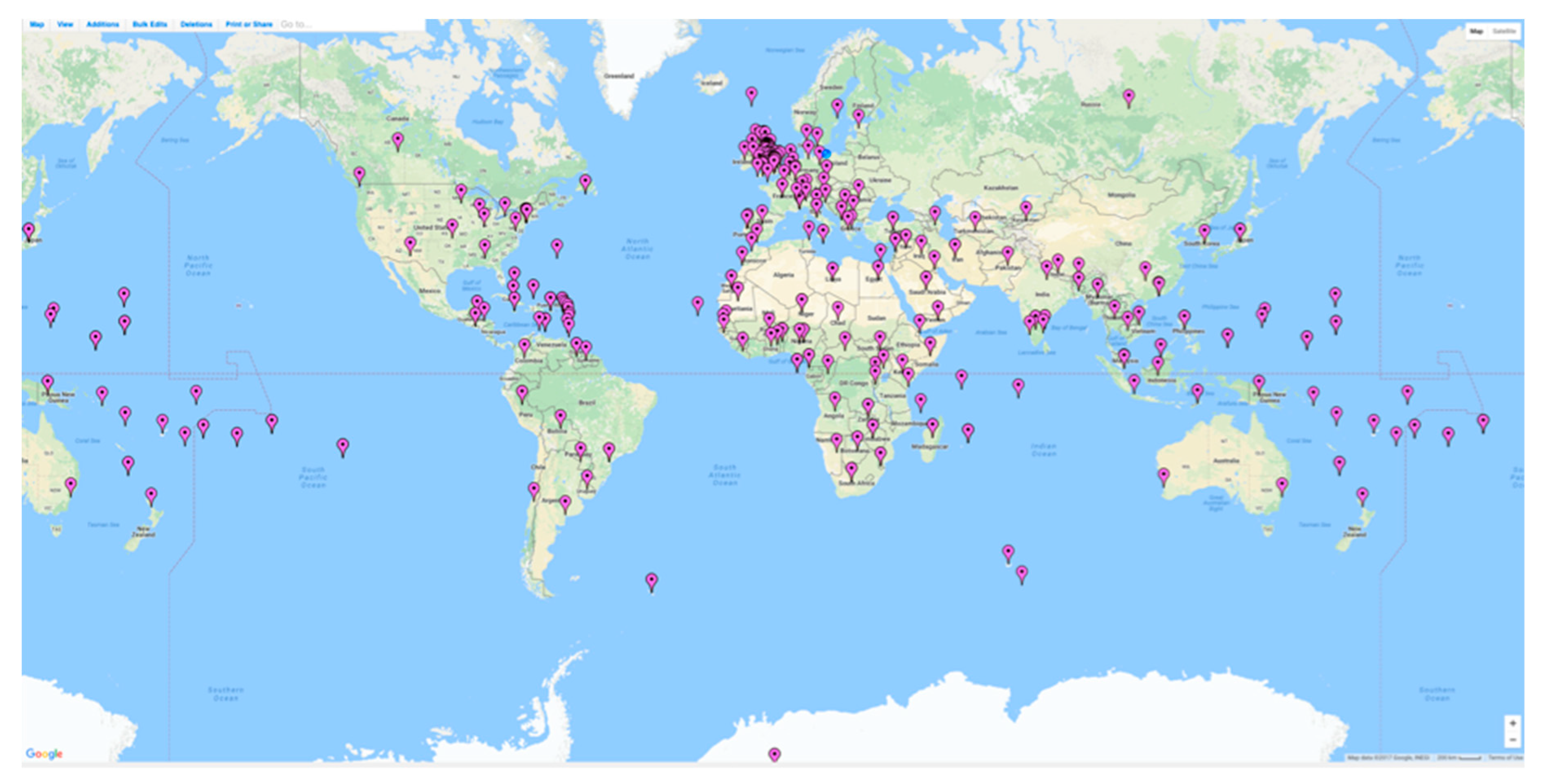
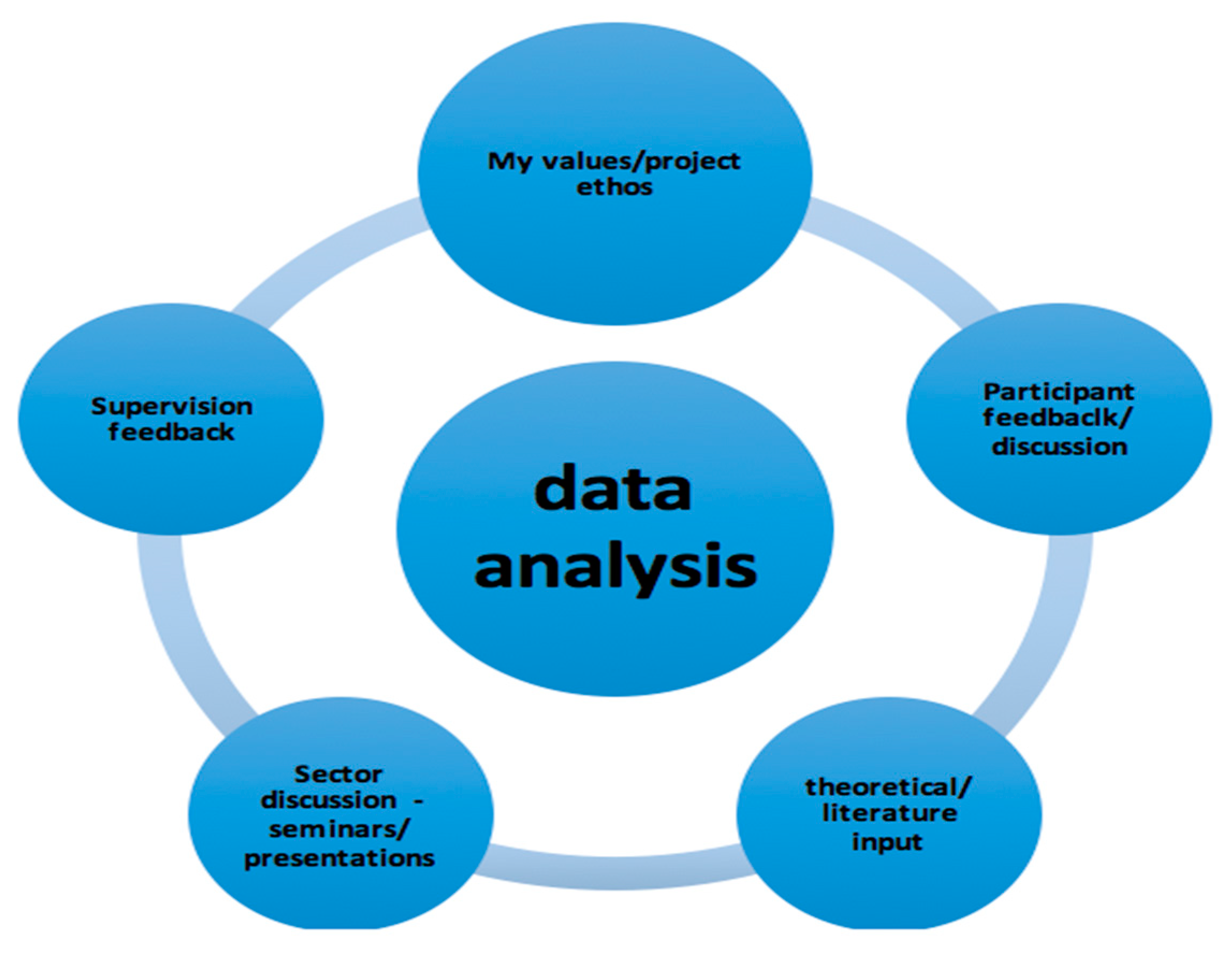
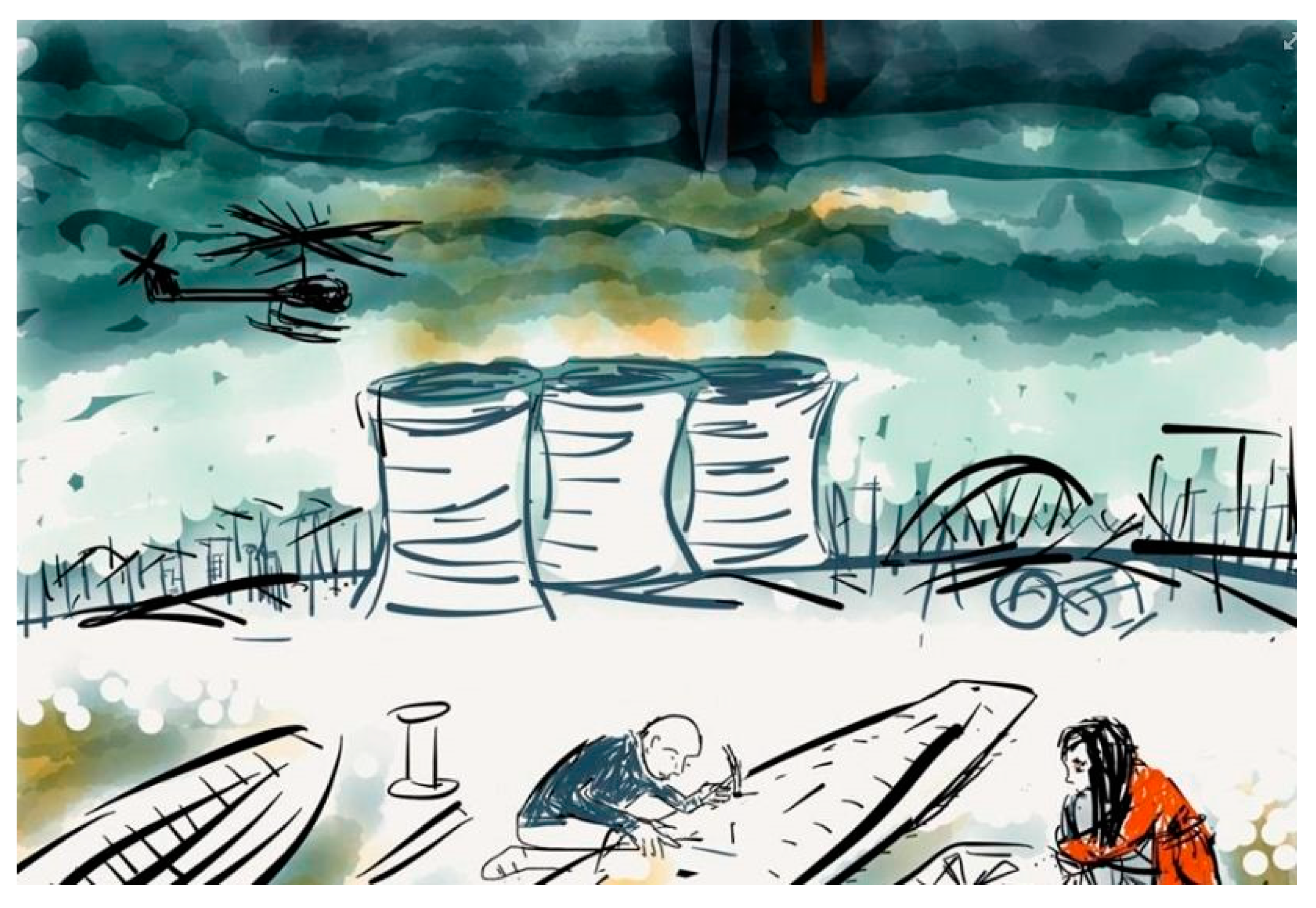
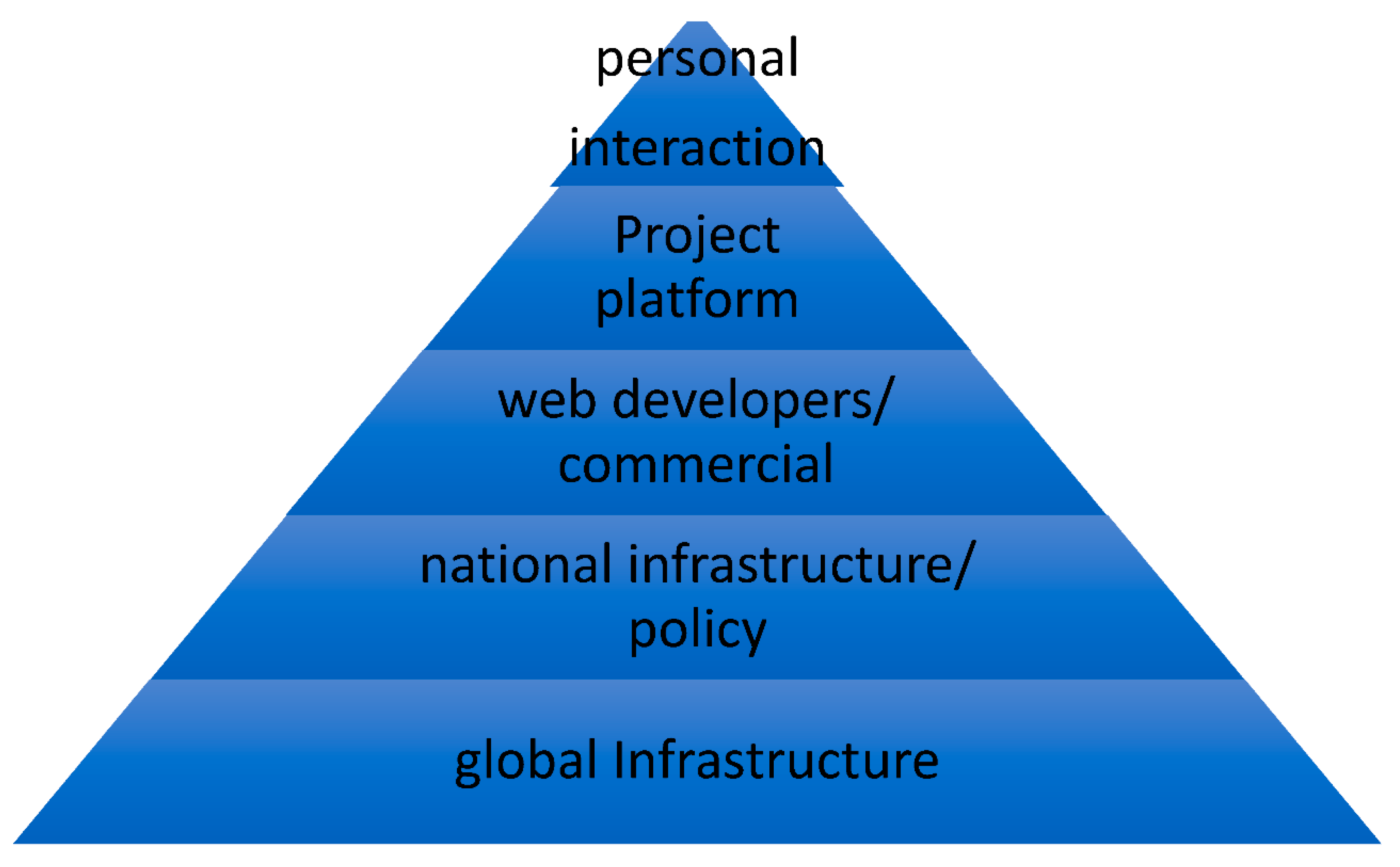
| COOCs | Connectivist cMOOC | XMOOC | |
|---|---|---|---|
| Teacher Role | Open to anyone; create course/network and make choices of topic and approach; no professional or institutional requirements | Open—tendency toward professional educators; facilitated network | ‘Star lecturers’; institutional affiliation; focus on transmission’ relocate institutional knowledge in free access space |
| Student/Learner | Free access; activities based on course. Access online and real world | No entry criteria; varied activity according to MOOC; contribution to network | No entry criteria; activities based on MOOC leader tasks |
| Content/Cognitive | Knowledge a blend of teacher/community-led. Nondiscipline specific and wide range of subject areas | Knowledge created through networks; student creativity integral. | Institutional disciplines and courses (Abridged/tailored for online transmission); teacher-created |
| ‘Key Elements’ of PAR Engagement | How These Were Realised in the Sample Frame |
|---|---|
| Relocation of power, primary researcher responsibilities | The participants involved in development of processes—open invitation to development meetings/decision making. Research processes dialogic. |
| Development of a sound dialectic | Multiple approaches to engagement implemented to avoid silencing participants/reifying others. Cycles developed based on participant exchange. |
| Generation of knowledge and understanding | Knowledge generation sought at both the collective and the individual level (without assumption these would coincide). |
| Development of shared quality criteria to ensure validity | Participation included decision making across all levels of platform design. Code of conduct created collectively; findings allow disagreement/upset/compromise as valid and informative inclusion. |
| Key Themes | Simply Put |
|---|---|
| Gatekeeping & Vulnerability | Institutional practices shape how things move and develop and so influence even those moves that seek alternatives to them. Vulnerability becomes a feature assigned by the powerful to those they consider powerless and helps them define who can and who cannot take part. |
| Pyramids of control | Various levels of awareness and concern exist about the technological infrastructure in which we live. It is necessary to give serious consideration to the ways in which different individuals and groups view the technologies that we ask them to be involved with. The concern that ‘we rarely contemplate how our surface world is propped up from below by darkness’ (Assange, ([46], p. 3)) should not be ignored and must form part of the structures we create/promote/use and the knowledge we include. |
| Challenging Common Sense | To begin to develop learning outside institutional norms requires a questioning of the common-sense assumptions we rely on. To do this, a reason to question these common-sense assumptions comes from recognising the failings such models have for many. The more we benefit from the common sense concepts, the less likely we are to challenge them. This section proposes a gonzo education based on the evidence from participant experiences. |
| Philosophies of Practice | To develop educational alternatives a crucial concern is establishing our philosophies-in-practice. This moves away from distanced theoretical awareness, metaphors and espoused discourse of philosophies. Instead, uses of technology and approaches to how we teach/learn are based on lived philosophies rooted in action. |
© 2019 by the author. Licensee MDPI, Basel, Switzerland. This article is an open access article distributed under the terms and conditions of the Creative Commons Attribution (CC BY) license (http://creativecommons.org/licenses/by/4.0/).
Share and Cite
Shukie, P. Teaching on Mars: Some Lessons Learned from an Earth-Bound Study into Community Open Online Courses (COOCs) as a Future Education Model Rooted in Social Justice. Sustainability 2019, 11, 6893. https://doi.org/10.3390/su11246893
Shukie P. Teaching on Mars: Some Lessons Learned from an Earth-Bound Study into Community Open Online Courses (COOCs) as a Future Education Model Rooted in Social Justice. Sustainability. 2019; 11(24):6893. https://doi.org/10.3390/su11246893
Chicago/Turabian StyleShukie, Peter. 2019. "Teaching on Mars: Some Lessons Learned from an Earth-Bound Study into Community Open Online Courses (COOCs) as a Future Education Model Rooted in Social Justice" Sustainability 11, no. 24: 6893. https://doi.org/10.3390/su11246893
APA StyleShukie, P. (2019). Teaching on Mars: Some Lessons Learned from an Earth-Bound Study into Community Open Online Courses (COOCs) as a Future Education Model Rooted in Social Justice. Sustainability, 11(24), 6893. https://doi.org/10.3390/su11246893





